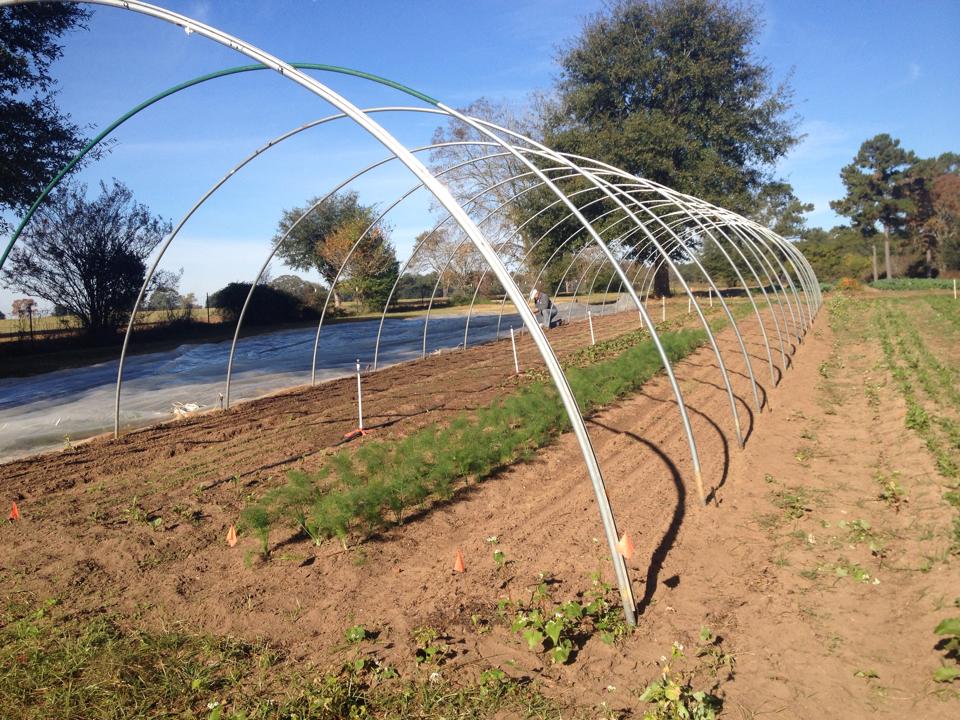While many peninsular Florida farmers do not have to worry about cold protection, farmers in the Florida Panhandle are certainly an exception. Most of the Panhandle is in zone 8b, which means average minimum temperatures are between 15 and 20°F. North Florida therefore experiences a few hard freezes – temperatures less than 28°F for over five hours – every year. Consecutive nights that get this cold can “burn” the tips of even the toughest crops. Frost damage is more likely to occur on clear nights, as heat that radiated down from the sun during the day will escape into the atmosphere at night, if clouds are not present. Although most of our cold weather occurs in January and February, we can expect our first frost around the second week of November.
It is important for fruit and vegetable farmers to use multiple means of cold protection. Here is a description of commonly used methods:
-
High tunnels
Although the initial investments of high tunnels can be costly, they can protect crops from extreme cold weather and promote early crop maturity. High tunnels are typically constructed using thick plastic sheeting stretched over a large metal frame, ranging from about 8 to 20 feet high. Tunnels work by increasing air and soil temperatures and by protecting crops from wind damage. Plastic siding should be designed so that it can be opened or rolled up during sunny days to allow for proper ventilation.
-
Row covers
Row covers are typically composed of polyethylene or another material that is porous and nonwoven. They are commonly used in North Florida for cold and wind protection. Wire hoops are usually used to support the row cover, which must not touch the plant, and although they can be vented or non-vented, non-vented covers will need to be manually opened on most sunny winter days in North Florida. Row covers also promote early crop maturity and can increase yields
-
Frost cloth
Frost cloth is breathable polyester fabric that is light weight and heat-retentive. It can moderate temperatures about 6-8°F. Wire hoops can be used to keep the cloth off the crop, but it is not essential. Most importantly, the cloth must touch the ground at all points to be effective, as it works by trapping heat that radiates from the soil and increases the humidity around the plant. Always wait until the outside air temperature is 50 to 60°F before you remove the cloth, as quick thawing can actually cause the most severe damage.
-
Hydration
Always remember to keep your crops well watered, as frost damage is actually dehydration. When ice crystals form on the leaf surface, it draws moisture from the leaf tissue. Damage will therefore be less severe if the plant is not already drought-stressed.
Being prepared for cold weather will help keep your winter crops going strong all the way into spring. Remember that healthy plants will be more resistant to cold weather than unhealthy plants, and investing in cold protection infrastructure can go a long way to ensure your fruits and vegetables survive our chilly North Florida winters.
For more information on this topic, please see the following UF/IFAS resources:
Row Covers for Commercial Vegetable Culture in Florida
Protected Culture for Vegetable and Small Fruit Crops: Types of Structures
Florida Automated Weather Network
- Choosing the Right Sales Model for Your Small Farm - July 31, 2025
- Specialty Peppers for Every Heat Level - January 31, 2025
- Understanding Short-Day vs. Long-Day Onions - July 26, 2024


